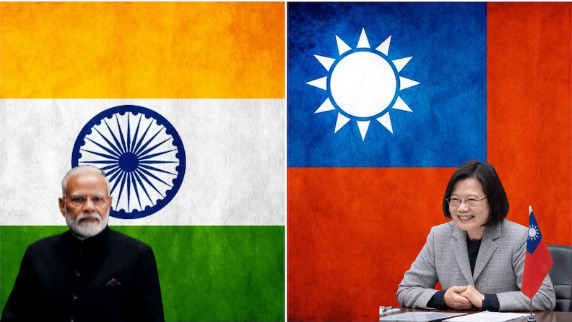Giving a jolt to One China policy, the Narendra Modi government is in advanced talks with Taiwan over bringing a chip plant worth an estimated $7.5 billion to India to supply everything from 5G devices to electric cars. Ever since the pandemic began, the rise in demand for electrical equipment has led to an increase in the demand for semiconductors. However, directly dealing with Taiwan is expected to antagonize China which considers Taiwan, a part of its authoritarian ‘One China’ Policy.
Why are semiconductors crucial?
Usually made of silicon, Semiconductors are a strategic technological asset in today’s globalised world. From car batteries to laptops to smartphones to household appliances to gaming consoles and everything in between, semiconductors perform the fulcrum of the job in powering smart electronic devices. The global semiconductor industry is valued at around 481 billion dollars as of 2018 and is dominated by companies from South Korea, Taiwan and Japan, all of which happen to be India’s friends.
China is desperate for semiconductors
Like India — for China too, semiconductors are an indispensable product. And in the last few months, China has also pushed for indigenous manufacturing of semiconductors because the Trump administration crippled its electronics industry with a ban on the export of American-designed models to China.
Reported extensively by TFI, the Chinese tech giant Huawei was cut to size after the Trump administration blacklisted the company and refused to sell the semiconductors to it. As a result of the ban on Huawei, China’s ‘Silicon Valley’ Shenzhen, where Huawei was born, has been crippled and faces acute economic distress.
Such has been the thirst for semiconductors that China has engaged in industrial espionage and talent-poaching to offset the semiconductor shortfalls. However, wary of the threat, Taiwan has asked staffing companies to remove all listings for jobs in China. This is a deliberate move by Taipei to avoid the outflow of Taiwanese talent to China.
Read more: Taiwan deals a major blow to Jinping’s semiconductor push, bans all recruitment for jobs in China
China tries to steal, India wants to create
India is also affected by the dearth of semiconductor supplies as the manufacturing process of other technological products stutters because of the delay in procuring semiconductors.
Semiconductors are a strategic asset and manufacturing semiconductors is a tedious as well as an arduous process. It takes months and the Government of India can no longer afford to wait for such a long duration if it wants to realise the $5 trillion economy dream by 2025. Thus, Prime Minister Narendra Modi is aggressively batting for bringing Semiconductor manufacturing into the country.
PM Modi Meeting Qualcomm CEO
PM Modi, on his trip to the US, met and discussed with chip giant Qualcomm’s chief executive officer (CEO) Cristiano Amon about the feasibility of setting up a camp in India. As per Ajay Sawhney, Secretary, Ministry of Electronics and Information Technology (MeitY), the government had received expressions of interest (EoIs) from several semiconductor firms and will come out with a scheme for semiconductors in the next six months.
The Production Linked Incentive (PLI) scheme in 10 sectors of the economy has already shown tangible benefits and hence it wouldn’t be a hyperbole to predict that government might come up with a similar one for the semiconductor sector.
The Quad strategising to cripple China’s technology industry
However, at the same time, PM Modi’s government wants to put China in its place. Recently, at the first-ever in-person Quadrilateral Security Dialogue, or what is more commonly known as the Quad, the ally countries, Japan, Australia and the USA, along with India have decided to end China’s global domination dreams with a single move- restructuring the semiconductor supply chains.
Nikkei reported that a draft joint statement suggested that the four nations are likely to confirm that “resilient, diverse and secure technology supply chains for hardware, software, and services” are crucial for their shared interests.
Chipmaking leaders like Taiwan and South Korea are the Quad’s friends and China’s adversaries. This is exactly why the Quad is trying to link semiconductor supplies with democratic values, as it directly decouples China from countries that manufacture semiconductors.
Read More: The great Chip alliance: Quad hits China where it hurts the most
Indian companies jumping on the wagon as well
N Chandrashekharan, chairman of the Tata Group, had confirmed last month that the company is also looking to enter the semiconductor space. While speaking at the annual general meeting of the IMC Chamber of Commerce and Industry, he said “At the Tata group, we have already pivoted into a number of new businesses like electronics manufacturing, 5G network equipment as well as semiconductors, in all probability.”
The Vedanta Group also seemed to be interested in forming strategic partnerships that will allow the company to enter the semiconductor industry.
India can become a tech powerhouse
Moreover, after starting semiconductor manufacturing, India could fill up the vacant space and become an electronics manufacturing powerhouse. A joint venture between U.S. smartphone chipmaker Qualcomm Inc and China’s Guizhou province had shut down back in 2019, this will be a big opportunity for India to take advantage of the situation to tackle the Chinese hegemony on the manufacturing unit.
Given the fact that India is already the second-largest player after the United States as far as the software industry is concerned, an edge in hardware manufacturing would make the country a tech powerhouse.
